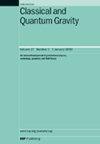探测时代脉冲星定时阵列调谐的灵敏度曲线方法
IF 3.6
3区 物理与天体物理
Q2 ASTRONOMY & ASTROPHYSICS
引用次数: 0
摘要
随着脉冲星定时阵列(PTA)进入随机引力波背景(GWB)的探测时代,PTA合作项目对其观测活动的回顾和可能的修订是非常重要的。探测到“单一源”将是引力天体物理学的福音,因为这样的源将在PTA频段发射数百万年的引力波。在这里,我们提出了研究各种观测策略影响的通用方法,利用检测器灵敏度曲线,即噪声平均,频域检测统计量。这些方法的统计基础连同如何将检测器调谐到单个,确定性信号或随机背景的无数例子一起提出。我们证明,将最差脉冲星的观测结果与最佳脉冲星上的高节奏运动进行交易,可以增加对高频单源的灵敏度,同时对冲GWB损失和低频单源灵敏度。我们还发现,与其他PTA调谐选项相比,以天空为目标的观测活动产生的灵敏度改进最小。最后,我们展示了GWB中不相关的那一半(即脉冲星项)作为日益突出的噪声源的重要性,并展示了这种新兴噪声源对各种PTA配置的影响。本文章由计算机程序翻译,如有差异,请以英文原文为准。
A sensitivity curve approach to tuning a pulsar timing array in the detection era
As pulsar timing arrays (PTAs) transition into the detection era of the stochastic gravitational wave background (GWB), it is important for PTA collaborations to review and possibly revise their observing campaigns. The detection of a ‘single source’ would be a boon for gravitational astrophysics, as such a source would emit gravitational waves for millions of years in the PTA frequency band. Here we present generic methods for studying the effects of various observational strategies, taking advantage of detector sensitivity curves, i.e. noise-averaged, frequency-domain detection statistics. The statistical basis for these methods is presented along with myriad examples of how to tune a detector towards single, deterministic signals or a stochastic background. We demonstrate that trading observations of the worst pulsars for high cadence campaigns on the best pulsars increases sensitivity to single sources at high frequencies while hedging losses in GWB and single source sensitivity at low frequencies. We also find that sky-targeted observing campaigns yield minimal sensitivity improvements compared with other PTA tuning options. Lastly, we show the importance of the uncorrelated half of the GWB, i.e. the pulsar-term, as an increasingly prominent sources of noise and show the impact of this emerging noise source on various PTA configurations.
求助全文
通过发布文献求助,成功后即可免费获取论文全文。
去求助
来源期刊

Classical and Quantum Gravity
物理-天文与天体物理
CiteScore
7.00
自引率
8.60%
发文量
301
审稿时长
2-4 weeks
期刊介绍:
Classical and Quantum Gravity is an established journal for physicists, mathematicians and cosmologists in the fields of gravitation and the theory of spacetime. The journal is now the acknowledged world leader in classical relativity and all areas of quantum gravity.
 求助内容:
求助内容: 应助结果提醒方式:
应助结果提醒方式:


